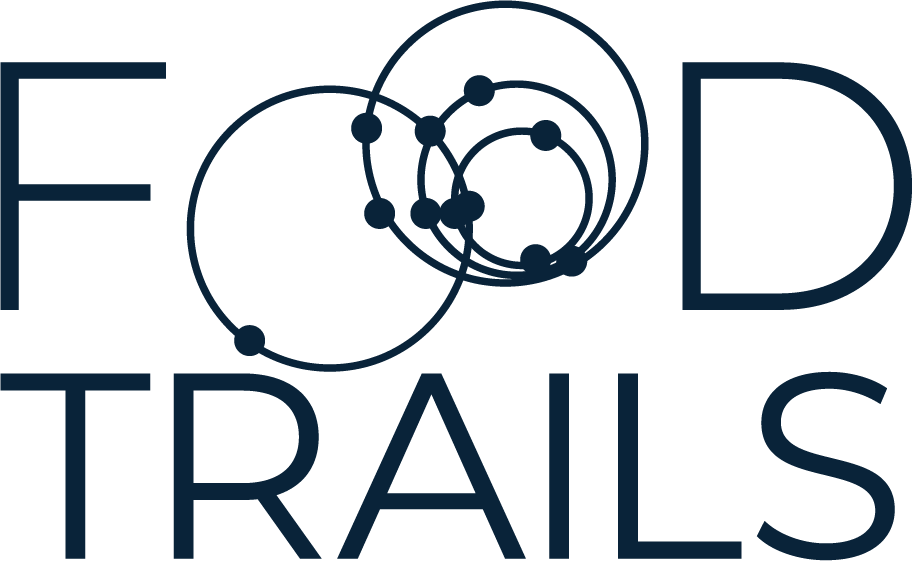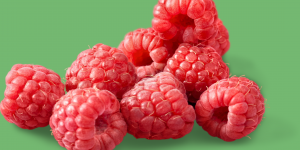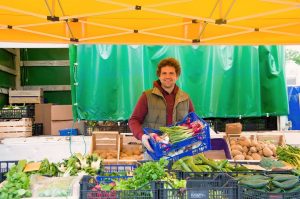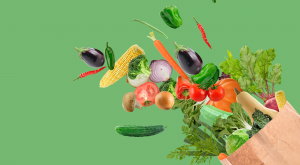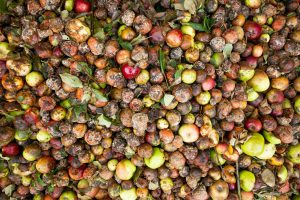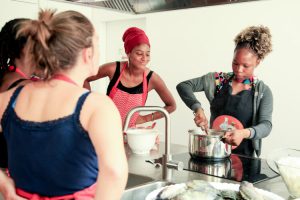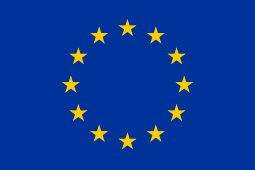If you saw the tattooed, bespectacled Jos Meijers riding around the Dutch city of Groningen on his motorcycle, leather jacket and fingernails generously caked with mud, you might wonder what he’s been getting up to. Perhaps a fresh cabbage or sack of potatoes under his arm might give you a hint.
“You have to imagine we do everything,” Meijers explains, “We do potatoes, carrots, tomatoes, bell peppers, hot peppers as well. And they’re grateful for everything. My wife is still the designer for the websites and all the flyers and stuff. Well, we’re both workaholics, my wife and I.
The work that Meijers is at present addicted to is a social and agricultural urban experiment of his own devising. It all started during a stint as a social worker when Meijers learned from some people whom he was working with that the local food banks stocked very few fresh vegetables. This was compounded on a shopping trip with his wife shortly afterwards, when he noticed the relatively high price of fresh vegetables.
A simple idea
Why don't we build a vegetable garden for the food bank?
“So, I just had a simple idea: Why don’t we build a vegetable garden for the food bank.” When his contract di lui came to an end, Meijers decided to throw himself full-tilt into the idea. “I thought, ‘I’m fed up working for a boss, I’m just going to build this garden and we’ll see what happens.'”
He set himself at the table and wrote up a 50-page plan for what he wanted to do. Then he looked down at what he had written and had a second realization, “Oh … nobody’s going to want to read that.” His wife, who works as a graphic designer, remedied this, converting the plan into a large visual that he could use to pitch the concept clearly.
Serendipitously, gears were turning in Groningen’s local government and in the European Union that would help bring Meijers’ idea to fruition. “I went to the municipality,” he remembers, “and I said, ‘hey, I need some space. Do we have a building and some vacant lot or something? ‘There was a new poverty policy with a line that said,’ maybe we should look into creating a vegetable garden in Groningen. ‘So I said,’ Hey, I already have the idea. Let’s collaborate. ‘And they said,’ Well, we think the idea is good and we can share a vacant lot with you. ‘”
Growing hybrids
We want to have a good and healthy food accessible for everyone
“The main goal of the food policy in Groningen is that we want to have a good and healthy food accessible for everyone,” declares Luchiena Lanjouw, Communications Officer at the Municipality of Groningen , “We have inhabitants who are unemployed and, well, relatively poor people. And we also want them to have access to good and healthy food. So we focus on the accessibility and on giving people skills to prepare food, maybe to grow it themselves, to join collective initiatives where they can cooperate. “They named the lot Toentje, which means’ little garden.
By combining policy areas, such as food and poverty, the Dutch city is trying to become a more efficient initiator of new ideas and facilitator of bottom-up ones. “It might surprise you,” confesses Renske Stumpel, Manager of EU Projects for the Municipality of Groningen, “that we’ve got four departments in the city: poverty, living quality, neighborhood policies and health, that all have their own goals in relation to food. We already have around 150 existing food initiatives in the city of Groningen. And we want to align them better to have a bigger impact on the people we want to reach.
For example, the city has a goal of becoming more environmentally sustainable by shortening food supply chains, avoiding the emissions of having vegetables and other food flown half-way across the world to reach our plates. It also wants to ensure that those in poverty do not suffer from hunger, that jobless people can find work and that migrants can integrate successfully into local society. As it happened, the next phase of Meijers’ work at Toentje ticked all four of those boxes, and so the city used one of its EU-funded projects, Food Trails , to work on it with him.
Food in translation
We have to translate the European policy to practical projects
“You have to make a translation,” says Meijers, “So that’s what Renske Stumpel is doing for us with Food Trails. She’s translating the practical ideas we have so that the European Union understands what they’re giving the budget to. We have to translate the European policy to practical projects. “That, Meijers says, is the difficult part, while the fun part is seeing their practical work becoming the fodder for new European policy.
In an ideal situation, what more would you want?
“We want to keep building on what we already have to lay the base for long-standing policy,” says Stumpel. “In Toentje, we’re giving a subsidy because there’s a social café there, volunteers working in the garden, there are people getting a training as a cook, for instance, they are doing all kinds of things in the neighborhood. Now, with Food Trails, we say ‘Ok, in an ideal situation, what more would you want?’ Well, he has a lot on his list. “
Food you can follow
Through the project, the municipality is turning some of its food hubs like Toentje into living labs, giving them support to try to enhance their efficacy as well as expanding or duplicating the models there to other parts of the city, as well as the partner cities involved in the project.
The new vegetables went down a treat at the local food bank. “Some clients are used to getting lettuce that is washed in ice water and in packaging and now they’re getting their lettuce with maybe sand on it, and they have to wash it doing themselves, which comes as a shock,” Meijers laughs, “But most of the people are really positive because they know where it’s from. They can take the bike and cycle to physically see the garden.”
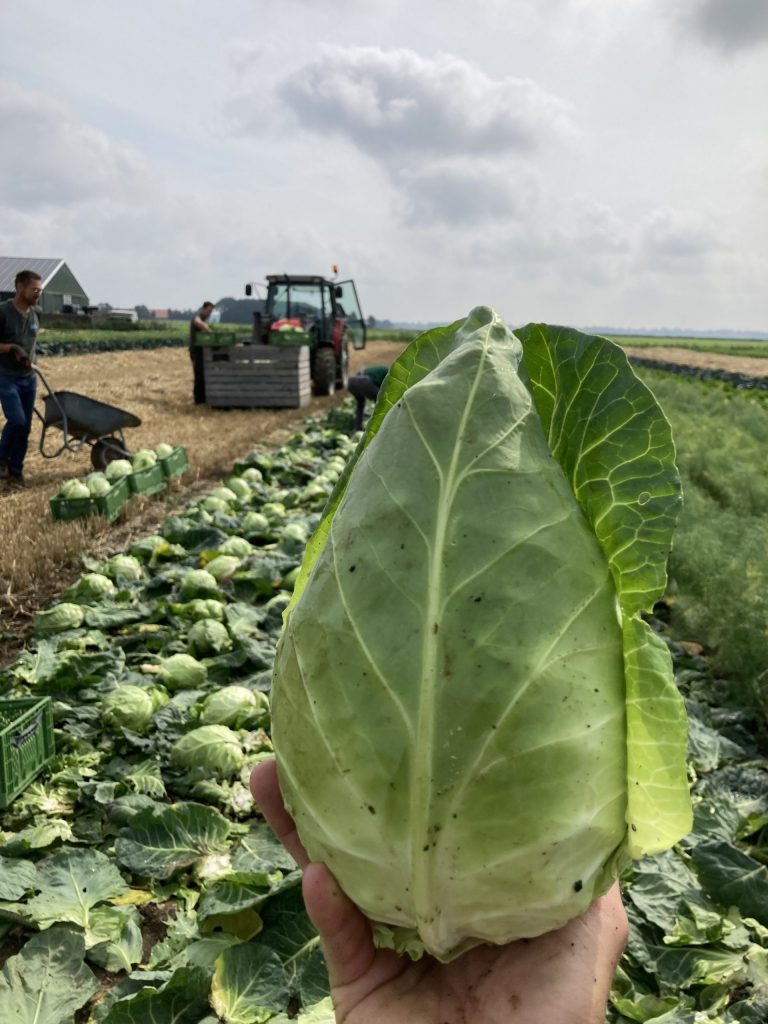
Back from the brink
The garden touches the lives of socially vulnerable people in Groningen in more ways than just through their stomach. Many of the people volunteering there have issues that have prevented them from entering regular work. By working in Toentje, they build the skills and experience that can boost their confidence and lead them to a paid job and a more fulfilling life.
“Our social company mixes up people from all walks of life, ex-homeless and expats, like you and me and everybody in between. You have a really positive dynamic that way, ”Meijers boasts.
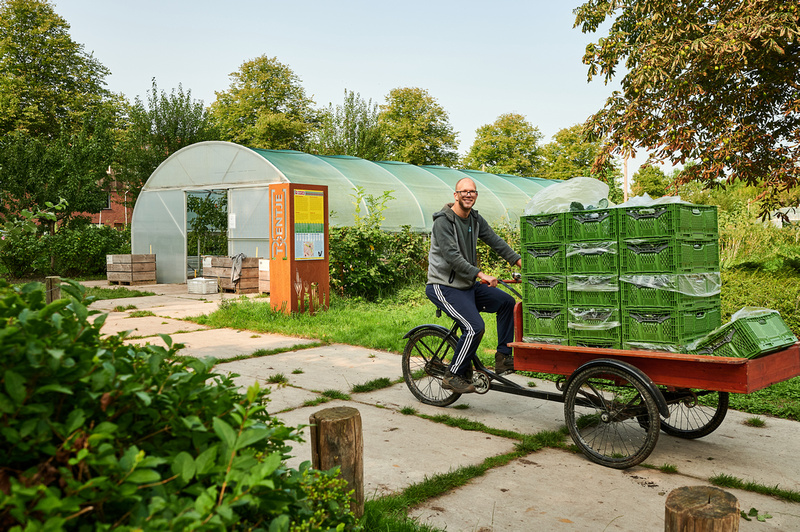
Before having children, who demanded slightly more regular hours, Meijers worked for a decade as a production manager for nightclubs. He remembers one person from his old life making a welcome transition into his new one.
“This guy from the North of Africa,” Meijers reminisces, “was homeless at the time and he was always using [heroin] and dancing and he was always the last one to leave the club where I worked. The guy started working at Toentje as well, and from being homeless he has a job now in landscaping.
She was cutting herself and having suicide attempts
An equally poignant story involves a young girl from a troubled family who was self-mutilating, “She was cutting herself and having suicide attempts and she was in a really bad state. But she was really strong as well. She worked at Toentje and from almost killing herself, after two-and-a-half years she picked up her study again and now she’s working helping people in a hospital. “
Shame and hunger
More than half of the those working in Toentje have difficulty finding a normal job, but a large number of them eventually go on to find regular work. “The municipality tries to help people get back towards work, we call it a ‘participation job,'” Stumpel elaborates. “It’s a first step, I would say, to getting back into the system of doing regular daily activities.” Stumpel says the targets of this activity are those stuck in what they term ‘generational poverty’ as well as those who are caught temporarily in unlucky circumstances.
Poverty often is accompanied with shame
Toentje is just one of many programs that the city supports to marry food policy and social policy. Another initiative, ‘Soup on the stoop’ allows you to buy a meal for someone who can’t afford it in your neighborhood. Stumpel chalks the success of this program up to the fact that people care deeply about their own neighborhoods, “It’s your people, the people you meet on the streets so you can do something.”
Lanjouw flags the need in such initiatives for special emphasis on the dignity of all parties. “Poverty often is accompanied with shame and feelings of introversion. If you’re poor, you don’t want to tell it to everyone.”
Leveling up
Toentje in particular has been so popular that it’s been forced to migrate to a second, even more exciting phase. “They had to produce so much it was almost too much for their small garden,” Lanjouw says, “so then they thought of a plan to produce extra vegetables with farmers from around the city.”
How did Meijers engineer a huge collaboration with local farmers to bring enormous quantities of fresh vegetables to people using his local food bank? “It’s really simple,” he answers in a typically pragmatic style, “We just started it.”
We just started it.

One local farmer was switching to organic produce, but as it takes two years for a plot of land to be deemed organic after normal use, he was happy to let Meijers and his team use one-and-a-half acres of his transitioning land for their project.
The second farmer working with them is running an experimental farm that is trying out new crops and new methods of regenerative farming. These methods include using smaller plots to avoid monoculture and ‘no till’ farming, where the farmer tries to disturb the earth as little as possible while planting and harvesting to protect soil ecosystems.
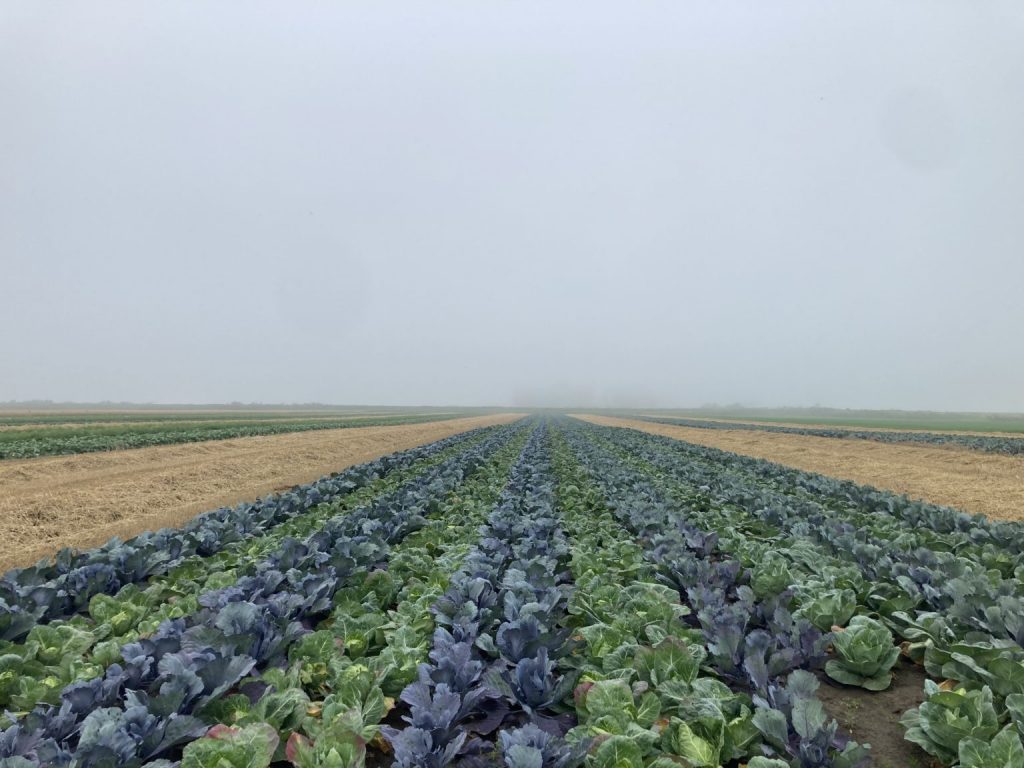
For these farmers, growing food for the food bank means that they can rely on a ready stock of volunteers to help them try out more labor-intensive farming methods. Now they’ve born such bounty that they are facing the reverse of their initial problem: they have gone from having too few vegetables to too many – so many that the three provinces of the Northern Netherlands lacked the capacity to take it all in.
Urban symbiosis
The relationship between the city and Toentje is a symbiotic one. On the one hand, the city gives the organization funding which allowed them to repurpose an old fruit juice factory. Groningen cooperates with, promotes and facilitates the initiative.
What’s in it for the city? Stumpel explains: “They already have a lot of connections in the neighborhood, in the city, with the food bank, with schools, with all kinds of charity institutions. There already is an existing network that we want to tap into, understand and support . “
Food is the best reason to come together
Strengthening this network is in the interest of the city, because its outcomes further local ambitions, including the renewal of disadvantaged neighborhoods, the promulgation of basic skills and improvement of health. “Food is the best reason to come together; for these neighborhoods, it’s a very good way to meet each other and have better health and better quality of life,” Lanjouw declares.
Better than clubbing
Stumpel says that, for them, facilitating people like Meijers, and attempting to replicate that success, is the most efficient way to use local resources to provoke change. “We facilitate these initiatives. Without Jos we wouldn’t have these connections. We wouldn’t have this myriad of ideas getting out. He gets things done. “
This is better than clubbing
As far as Meijers is concerned, he has no regrets about moving from a world of drum n ‘bass beats to a world of cabbages, peppers and beets. “This is better than clubbing,” he asserts. In the earthy ambience of the urban garden, it’s easier for him to hear all the people he’s chatting with, and the earlier hours in the garden mean that he can watch the generative power of the sun (and rain) spreading across Groningen, in place of the wild pull of the moon.
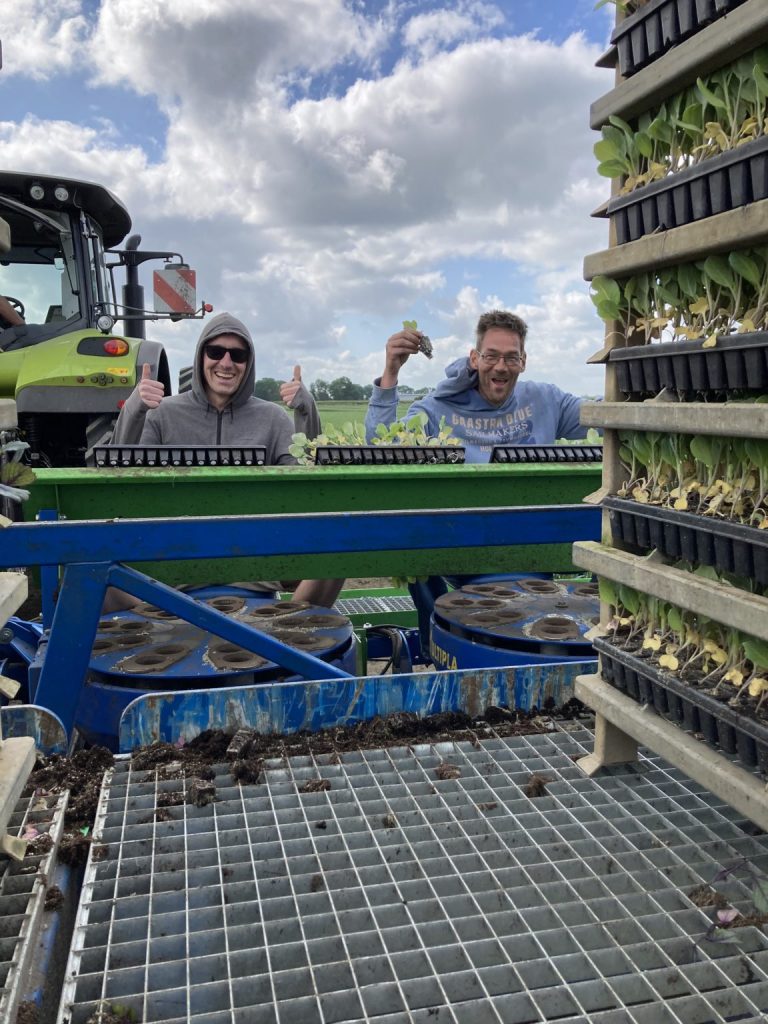
Another day at work.
